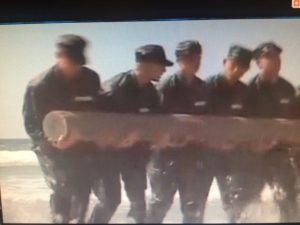It is a question that comes up frequently in forums, gyms, and recruitment offices. Can women be Navy SEALs? The direct answer is yes, they can. Policy has changed, and the door is officially open for any woman who believes she has the necessary grit and capability.
However, the journey is one of the most difficult in the military world. Knowing women can be Navy SEALs is very different from actually becoming one. The path requires passing the same punishing standards that have always been in place.

Table of Contents:
- The Policy Shift: Opening the Doors to All Combat Roles
- Can Women Be Navy SEALs? The Official Answer
- Initial Requirements: More Than Just Physical Fitness
- The Grueling Path: What is BUD/S?
- The Unchanged Physical and Mental Standards
- Have Any Women Tried to Become Navy SEALs?
- Other Elite Roles Women Fill in Naval Special Warfare
- The Ongoing Debate and Future Outlook
- Conclusion
The Policy Shift: Opening the Doors to All Combat Roles
For a long time, the rules were different, and specific military combat jobs were restricted to men based on a 1994 policy. This began to shift in 2013 when the Pentagon initiated a process to lift the ban on women serving in front-line combat roles. This review examined the physical requirements and practicalities of integration across the armed services, including the Army and Air Force.
The final decision came in late 2015 when the Secretary of Defense announced all military combat positions would open to women without exception. This landmark change included the most demanding special operations units. For the first time, a woman could officially pursue a career as a Navy SEAL.
Can Women Be Navy SEALs? The Official Answer
Following the Department of Defense’s directive, the U.S. Navy officially opened the path for women into its most elite units. The message from Naval Special Warfare Command was direct and clear. The standards would not change for anyone.
Anyone, male or female, who wants to become a SEAL must pass the same brutal selection process and training pipeline. It is a completely gender-neutral system where the focus is entirely on performance and meeting established high standards. This means a female Navy candidate who can meet every single requirement will earn her Trident, just like her male counterparts.
The Navy is not creating a separate path or lowering the bar. It is about capability, not gender. This commitment to a single, high standard is central to the integrity of all Naval Special Warfare programs.
Initial Requirements: More Than Just Physical Fitness
Before a candidate can even think about the physical tests, there are several administrative hurdles to clear. Every aspiring SEAL must be a U.S. citizen between the ages of 17 and 28. Waivers for age are sometimes possible but are not guaranteed.
Candidates must also possess a high school diploma or GED. Vision must be correctable to 20/25, and color blindness is disqualifying. These initial screenings filter many applicants out from the start.
A critical step is passing the Armed Services Vocational Aptitude Battery (ASVAB). This is not just a general aptitude battery; specific scores are required in areas like Mechanical Comprehension and General Science. The services vocational aptitude test helps determine if a candidate has the mental capacity for the technical aspects of the job. Strong scores on the armed services vocational aptitude battery are a non-negotiable part of the application.
Finally, every candidate must undergo a comprehensive physical examination to ensure they are medically fit for the rigors of SEAL training. They also need to be able to qualify for a secret security clearance. This process involves a thorough background check into a candidate’s history and character.
The Grueling Path: What is BUD/S?
To understand the challenge, you have to understand BUD/S. This stands for Basic Underwater Demolition/SEAL training. It is the legendary six-month course that forges SEAL operators through intense warfare training.
BUD/S pushes candidates to their absolute physical and mental limits. The goal is to find the few individuals who can perform under extreme stress, sleep deprivation, and physical pain. The attrition rate is incredibly high, with over 75% of candidates typically failing to complete the seal training course.
The training is broken down into three phases, each lasting several weeks. Each one tests a different set of skills and pushes you in new ways. The entire process is a continuous readiness test of a person’s body and spirit.
Phase 1: The Grind of Physical Conditioning
The first phase is seven weeks long and focuses on physical conditioning and building teamwork. This is where the majority of candidates drop out due to the sheer physical demands and extreme mental pressure. It is a constant grind of running in boots on sand, swimming in cold water, and calisthenics, often while carrying heavy logs and boats.
This phase of initial training is intended to test your physical durability, ability to work with a team, and mental toughness. It systematically breaks down individuals and rebuilds them as part of a cohesive unit. This phase culminates in what many consider the ultimate test of human endurance.
Hell Week: Five Days of Pure Misery
Inside Phase 1 is the infamous Hell Week. It consists of five and a half days of continuous training where candidates get a total of about four hours of sleep for the entire week. They are constantly cold, wet, hungry, and exhausted while facing non-stop physical challenges.
They run more than 200 miles and do physical training for hours on end under the watch of instructors who offer them every opportunity to quit. Hell Week tests a person’s will to continue when every part of their body and mind is screaming to stop. Surviving it is a massive milestone, but it is only the end of the beginning.
Phase 2: Mastering the Water
Phase two is all about combat diving, a core skill for any SEAL. This eight-week block, often called dive school, is where candidates become combat swimmers. They learn to use SCUBA gear and become completely effective and comfortable in the water, day or night.
This phase is as much a mental test as a physical one, challenging those who fear dark, enclosed spaces or deep water. Training involves timed underwater navigation, diver preparation, and problem-solving exercises. A candidate must become completely at home in the unforgiving ocean environment.
The skills taught in this class dive school are highly technical. They include mixed gas diving for deeper operations and dealing with complex equipment. Learning to handle emergency situations underwater is a massive part of the curriculum.
Phase 3: Land Warfare and Explosives
The final phase moves to San Clemente Island off the coast of California. This eight-week phase focuses on basic and advanced land warfare. Candidates learn about weapons, demolitions, small unit tactics, and patrolling in a realistic environment.
Here, they learn the core skills of operating on land, practicing ambushes, raids, and reconnaissance missions for long hours. This final step solidifies the tactical foundation of a future special warfare operator. The training involves live-fire exercises and handling explosives, a skillset that includes everything from welding demolition to setting complex charges.
This phase also introduces technical skills that might be needed in maritime environments. This can include underwater hydraulic tools and underwater cutting equipment. Candidates may even be exposed to recompression chamber operations, a critical skill for any advanced diver.
The Unchanged Physical and Mental Standards
A common misconception was that fitness standards would have to be lowered for women to pass. The military has been firm that the standards are the standards and have not been changed. To even get a contract for SEAL training, a candidate must first pass the Physical Screening Test (PST) with competitive scores.
Merely meeting the minimums will not be enough to get you to BUD/S. Successful candidates typically demolish these minimum scores. This initial physical readiness test is just the first of many assessments of physical readiness.
Here are the minimum scores you need just to qualify:
| Exercise | Minimum Standard |
| Swim 500 yards | 12 minutes, 30 seconds. |
| Push-ups in 2 minutes | 50. |
| Sit-ups in 2 minutes | 50. |
| Pull-ups | 10. |
| Run 1.5 miles | 10 minutes, 30 seconds. |
Again, these are the rock-bottom minimums. A competitive candidate might swim the 500 yards in under 8 minutes, do over 100 push-ups and sit-ups, perform more than 20 pull-ups, and run the 1.5 miles in under 9 minutes. This level of physical preparedness is necessary just to survive the first few weeks of boot camp and subsequent training.

Have Any Women Tried to Become Navy SEALs?
Since the policy changed, a few women have attempted the challenging training pipeline. This is a very private process, so public information is limited due to the military’s strict privacy policy. The Navy does not publicize the identities of its special operations candidates for security and personal reasons.
In 2017, the first woman began the process to become a Special Warfare Operator. She entered the initial indoctrination phase but did not advance to BUD/S. While she did not make it through, her attempt was an important first step, showing that women were actively pursuing the opportunity.
Other women have entered the pipeline for different but related Naval Special Warfare roles. One woman successfully completed the grueling 37-week training course to become a Naval Special Warfare Combatant-Craft Crewman (SWCC). While not a SEAL, these warfare combatant-craft operators work closely with them and have their own exceptionally tough selection process.
Other Elite Roles Women Fill in Naval Special Warfare
It is important to know that women have served alongside SEAL teams for years. They have played essential support roles that are vital to mission success. These roles include intelligence analysts, cryptologists, logistics specialists, and many more.
Women have also served in other elite military units with great success. The Army’s Cultural Support Teams (CSTs) are a perfect example of their impact. These teams of female soldiers were attached to special operations units in Afghanistan to connect with the local female population, a task male soldiers could not do.
Additionally, several women have graduated from the Army’s notoriously difficult Ranger School. This course is one of the most physically and mentally demanding leadership schools in the U.S. military. Their success helps demonstrate that women can and do pass some of the toughest military courses in the world.
The Ongoing Debate and Future Outlook
The integration of women into combat roles was not without discussion. Some voiced concerns about physical differences between the sexes and the potential impact on unit cohesion. However, the military’s official stance is that performance is the only metric that matters.
Physiological differences between men and women are real. Men generally have greater muscle mass and upper body strength on average. Military research, however, focuses on the physical output required for any human body to meet the standard, regardless of gender.
The military leadership is committed to this path. The leadership in Naval Special Warfare fully expects that a woman will eventually complete BUD/S and earn her SEAL Trident. It is viewed as a matter of when, not if.
The path is open, and the standard is set in stone. The challenge is waiting for the right candidate with the necessary combination of physical strength, endurance, and unbreakable mental fortitude. The first female Navy SEAL will be an individual who exceeds every one of these high standards.
Conclusion
Let’s circle back to the original question: can women be Navy SEALs? The answer is an undeniable yes. The policies and laws are in place to allow any qualified American, man or woman, to attempt the difficult training.
No woman has yet earned the coveted Trident, but the opportunity is real and present. The standards are incredibly high for a reason, and they have not been lowered one inch. The physical requirements and mental barriers are the same for everyone who steps onto the beach in Coronado.
For now, the question is not about whether a woman can become a Navy SEAL. The real question is who will be the first one to do it.
Want more military info? Find your nearest military recruiter here!
